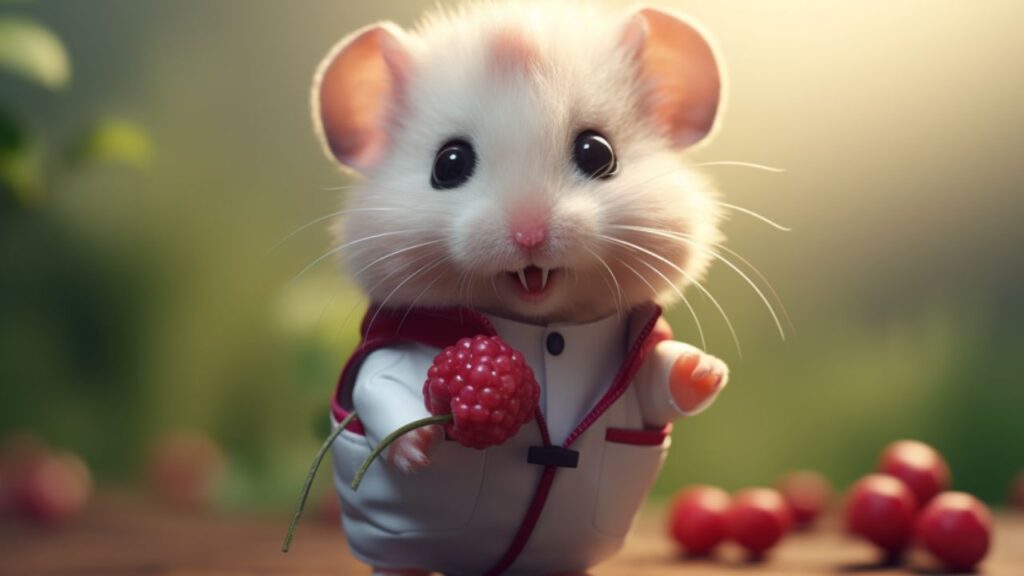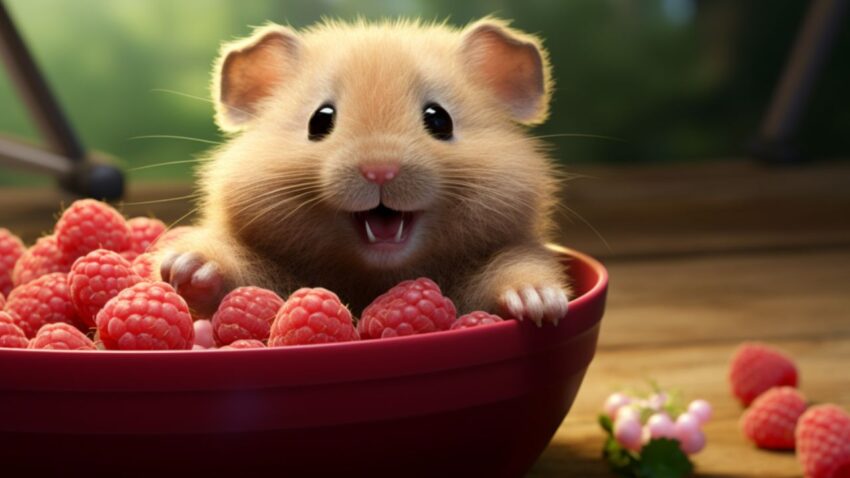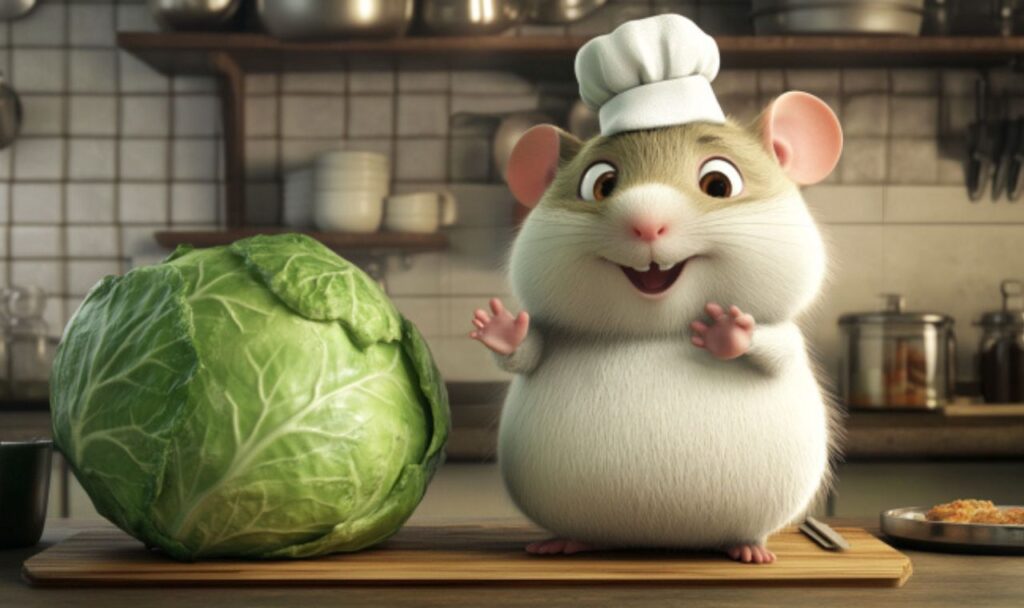TL;DR Summary
Yes, hamsters can have raspberries, but it’s important to feed them in moderation due to their high sugar content. Raspberries can offer health benefits to hamsters, providing vitamins, minerals, and fiber that can contribute to a balanced diet. However, they should be introduced slowly and given as an occasional treat to avoid digestive issues and prevent health problems like obesity and diabetes. Always ensure raspberries are fresh, washed, and served in small pieces suitable for a hamster. Monitoring your pet’s reaction to new treats is crucial, and any sign of adverse effects should prompt a dietary adjustment. Remember, a happy hamster is a wheel-y happy you!
In the diverse world of hamster nutrition, understanding the spectrum of a balanced diet is key to nurturing a happy and healthy pet. Hamsters, with their naturally omnivorous habits, require a diet that is rich in variety, offering a mix of grains, vegetables, proteins, and fruits to meet their nutritional needs. Among the plethora of food choices, fruit can be a delightful treat for these small creatures, but it’s crucial to know which fruits are safe and beneficial for them.
The Place of Fruit in a Hamster’s Diet
While hamsters relish an assortment of food items, fruits like raspberries can provide them with a welcome change from their regular meals. These berries are not only juicy and flavorful but also carry a host of vitamins and antioxidants that can contribute positively to a hamster’s health. However, the natural sugars present in fruit require us to feed them in moderation to prevent health issues. As we consider the inclusion of raspberries in a hamster’s diet, we must do so with an understanding of their nutritional impact and how to properly integrate them into our furry friends’ feeding regimen.
In the following sections, we will delve into the details of raspberries as a potential treat for hamsters, looking at the benefits they offer and the precautions that should be taken to ensure these treats remain a healthy part of a hamster’s diet.
Nutritional Profile of Raspberries

Raspberries are often celebrated for their vibrant color and tangy taste, but beyond their sensory appeal, they boast an impressive nutritional profile. These berries are a powerhouse of essential nutrients, each serving a purpose in supporting the health of those who consume them, including our petite hamster friends.
Vitamins and Minerals in Raspberries
Raspberries are rich in vitamin C, an antioxidant that plays a critical role in immune system function, helping to protect hamsters against disease. They also contain smaller amounts of vitamins A and K, folate, and minerals like potassium and magnesium. These vitamins and minerals are vital for maintaining good health, contributing to everything from strong bones to proper nerve function.
The Role of Fiber
Fiber is another key component found in raspberries. While hamsters require a diet that’s low in fat and high in fiber to prevent obesity and digestive problems, the fiber in raspberries can aid in digestive health, ensuring smooth gastrointestinal function. This is crucial as hamsters are prone to issues like diarrhea and constipation, and a proper fiber intake can help prevent such conditions.
The nutrients found in raspberries can offer various health benefits to hamsters when incorporated into their diet in the right amounts. The antioxidants help in preventing chronic diseases, while the fiber content aids in digestion. However, it’s essential to remember that fruits like raspberries should only be a small part of a hamster’s diet, given their high sugar content, which can lead to obesity and diabetes if overfed.
In the next section, we’ll explore how to safely introduce raspberries into a hamster’s diet, ensuring that these nutritional benefits can be enjoyed without any adverse effects.
Feeding Raspberries to Hamsters

Introducing raspberries into a hamster’s diet can be a delightful treat for your furry companion, but it should be done with caution to ensure their safety and health. These succulent fruits are packed with flavor and nutrients, yet their sugar content demands moderation.
Introducing Raspberries Safely
To safely incorporate raspberries into your hamster’s diet, start with these steps:
- Wash Thoroughly: Always wash raspberries under cool water to remove any pesticides or contaminants that could harm your hamster.
- Start Small: Begin by offering a tiny piece of raspberry to see how your hamster reacts. Not all hamsters will like every fruit, and it’s also important to observe for any adverse reactions.
- Monitor Closely: After the initial introduction, watch your hamster for any changes in their stool or signs of digestive discomfort, which can indicate intolerance to the fruit.
Serving Size and Frequency
Raspberries should be considered a treat, not a staple in your hamster’s diet. Follow these guidelines for serving size and frequency:
- Portion Control: A small raspberry or a piece the size of a blueberry is plenty for a hamster. Remember, hamsters are much smaller than humans, and what seems like a small portion to us is significant to them.
- Frequency: Offer raspberries no more than once a week. This helps to prevent health issues related to overconsumption of sugar and ensures a balanced diet.
- Dietary Balance: Always balance the fruit treats with a staple diet of hamster pellets, fresh vegetables, and occasional protein sources.
Feeding raspberries to your hamster can be a wonderful way to enrich their diet and provide them with additional hydration and nutrition. However, the key is to maintain balance and moderation. By adhering to these guidelines, you can indulge your hamster with this tasty berry without risking their health. Always keep a watchful eye on your hamster’s reaction to new foods and consult with a veterinarian if you have any concerns about their diet or health.
Potential Risks and Considerations

Incorporating raspberries into a hamster’s diet, while beneficial when done correctly, is not without its risks. These risks stem primarily from the natural sugar content in raspberries and the potential for digestive issues if consumed in excess.
Risks Associated with Sugar Content
Raspberries contain natural sugars, which, in small quantities, can be a harmless treat for your hamster. However, hamsters have a limited ability to process large amounts of sugar, and overconsumption can lead to:
- Obesity: Excess weight can be a serious health problem for hamsters, leading to decreased mobility and a higher risk of heart disease.
- Diabetes: Hamsters, particularly the Dwarf breed, are prone to diabetes, and a diet high in sugar can exacerbate this condition.
- Dental Problems: Sugary diets can lead to tooth decay in hamsters, causing pain and difficulty eating.
Digestive Issues and How to Avoid Them
The fiber in raspberries, while beneficial for digestion, can also cause gastrointestinal upset if a hamster is not used to it. Overfeeding raspberries can lead to:
- Diarrhea: A sudden influx of fiber can cause loose stools or diarrhea, which can lead to dehydration and discomfort.
- Gastrointestinal Distress: An overload of fruit can disrupt the delicate balance of a hamster’s digestive system, leading to bloating and pain.
To minimize these risks, consider the following tips:
- Moderation is Key: Always adhere to the recommended serving sizes and frequency to prevent overconsumption of sugar and fiber.
- Slow Introduction: Gradually introduce raspberries into your hamster’s diet to allow their digestive system to adjust.
- Observe Reactions: After feeding raspberries, observe your hamster for any signs of discomfort or changes in their stool.
- Maintain a Balanced Diet: Ensure that treats like raspberries are only a small part of a well-rounded diet.
By being mindful of these potential risks and following the tips provided, you can safely offer raspberries to your hamster as an occasional treat. Always watch for any changes in your hamster’s health and behavior, and consult with a veterinarian if you notice any issues. With thoughtful care, raspberries can be a delightful addition to your hamster’s dietary routine.
Whisker Tips

Treats can be a delightful addition to your hamster’s diet when given responsibly. Raspberries, along with a variety of other fruits, can provide both health benefits and enjoyment. Here’s how you can incorporate these treats safely into your hamster’s dietary routine.
Integrating Fruits into Your Hamster’s Diet
- Freshness First: Always choose fresh, ripe fruits, and wash them thoroughly to remove any pesticides or residues that could harm your hamster.
- Portion Control: Cut fruits, including raspberries, into small, manageable pieces. A portion the size of a raspberry or smaller is sufficient for a single serving.
- Variety Matters: Rotate between different types of fruits to provide a range of nutrients and flavors. This not only keeps your hamster interested but also helps avoid the buildup of any single type of sugar.
- Slow Introduction: When introducing a new fruit, do it gradually to monitor how your hamster responds, both in taste preference and digestive reaction.
- Observe and Adjust: Pay attention to your hamster’s behavior and stool after eating fruit. If you notice any adverse reactions, reduce the amount or frequency, or eliminate that fruit from their diet.
The Role of Moderation in Treats
- Balance is Key: Treats like raspberries should complement a diet primarily made up of high-quality hamster pellets, fresh vegetables, and the occasional protein source.
- Scheduled Treats: Designate certain days for fruit treats to avoid daily sugar intake and maintain excitement for these special snacks.
- Avoid Overindulgence: Even if your hamster eagerly consumes fruit, resist the urge to overfeed. The novelty of treats can maintain training incentives and dietary interest.
Offering a variety of fruits in moderation ensures that your hamster enjoys these tasty morsels without experiencing the negative side effects of overindulgence. Treats should be just that—a treat, not a staple. By following these “Whisker Tips,” you’ll provide your hamster with not only a nutritious and enjoyable diet but also one that supports their long-term health and happiness.
Remember, the goal is to see your hamster thrive, and a balanced diet is a cornerstone of their well-being. A happy hamster, with a diet rich in variety and moderation, is indeed a wheel-y happy you!
Conclusion

As we come to the end of our berry-infused journey, it’s clear that while raspberries can be a tasty and nutritious treat for hamsters, they must be given with careful consideration. We’ve navigated through the nutritional landscape of these fruits, highlighting the wealth of vitamins, minerals, and fiber they contain, and how these can benefit our furry friends in small doses.
Summarizing the Berry Basics
Moderation is the golden rule when incorporating raspberries into a hamster’s diet. The sugar content, while natural, requires us to offer these treats sparingly to prevent health complications such as obesity and diabetes. We’ve also touched on the importance of observing how your hamster reacts to raspberries, as individual tolerance can vary, and what is delightful for one hamster may be distressing for another.
The Big Picture of Fruity Treats
A varied diet that mirrors the richness of a hamster’s natural foraging menu not only satisfies their nutritional needs but also caters to their curiosity and love for exploration. Raspberries, along with other hamster-safe fruits, should be introduced slowly and remain a minor part of their overall diet, ensuring that the primary nutrition comes from balanced, hamster-specific food.
It’s the joy in the little things—a hamster’s enthusiastic nibble on a raspberry piece or their contented grooming after a meal—that reminds us of the pleasures of pet ownership. By adhering to the guidelines we’ve discussed, you can ensure that each treat contributes positively to your hamster’s health and vitality.
In essence, the well-being of our hamster companions is a reflection of the care and thought we put into every aspect of their lives, from their daily diet to the love and attention we bestow upon them. As you sprinkle their lives with the sweetness of raspberries and the richness of a balanced diet, you’ll reap the rewards of their happiness and well-being. Remember, a happy hamster is a wheel-y happy you!




